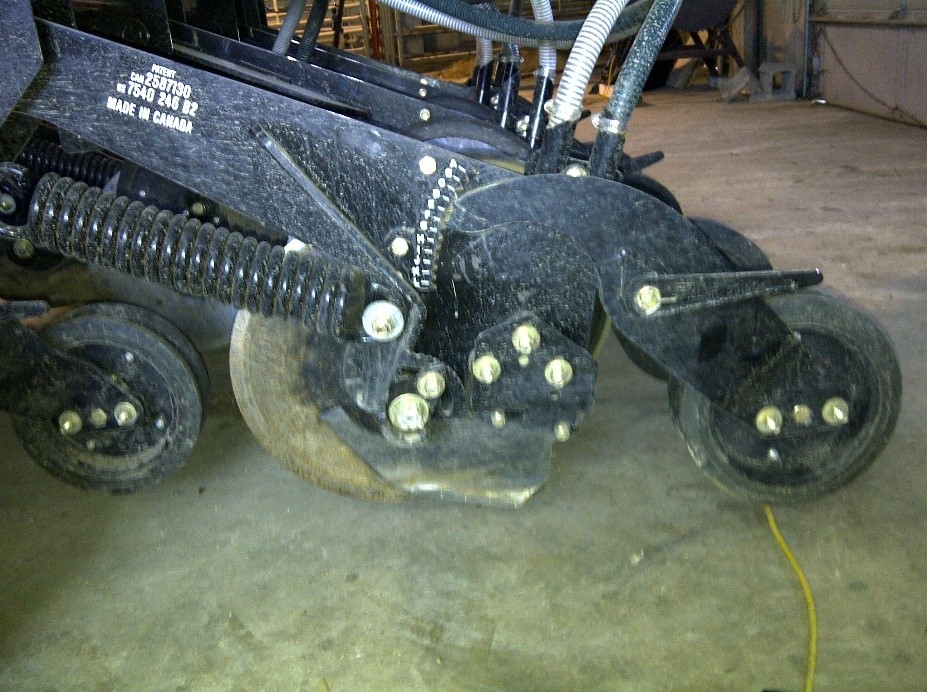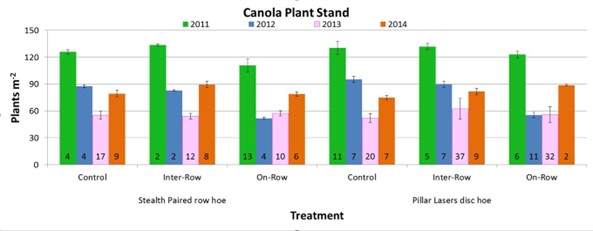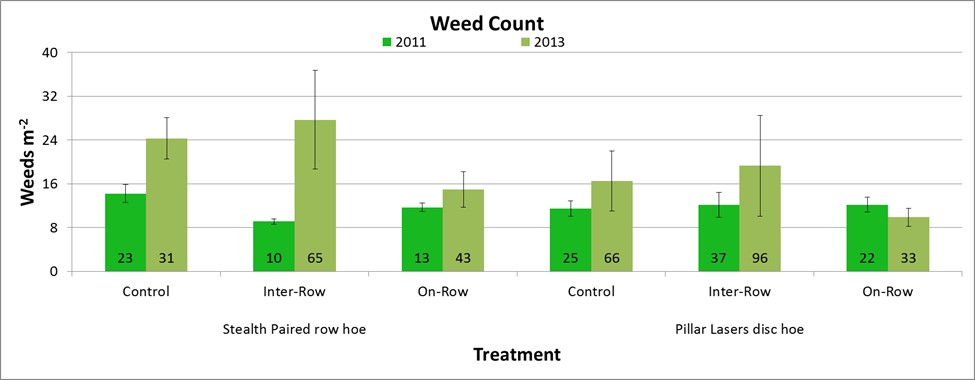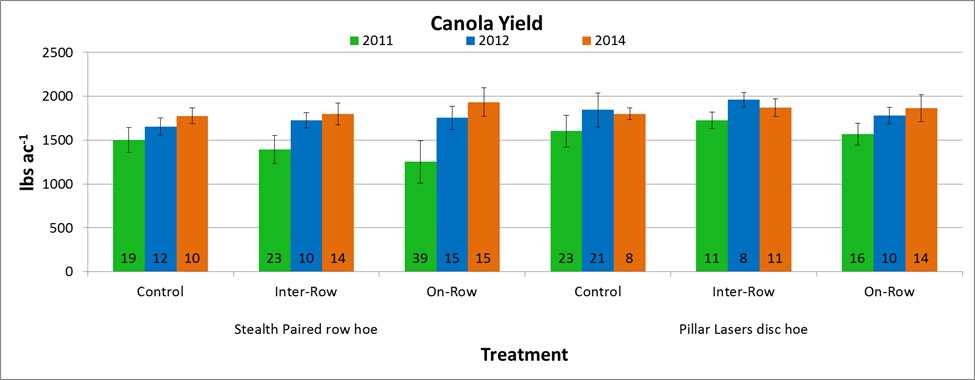Project AbstractHighly accurate GPS guidance and automated steering has given producers the ability to seed between the stubble rows from previous crops. This practice may allow for improved canola emergence due to more accurate seed placement, improved seed to soil contact, improved micro-climate, higher soil temperatures, and seedling protection from more standing stubble. In previous studies, Farming Smarter had observed that seeding on-row significantly reduced plant stand establishment in canola compared to seeding between the row and check plots. Additionally, canola yield was significantly higher with pillar laser disc/hoe openers compared to stealth paired row and generally not affected by row placement. This study determined the benefits of practices such as inter-row seeding, that could be enabled through precise GPS guidance, to increase farmer profits or decrease costs. Inter-row seeding could allow for taller standing stubble which is proven to help increase yields in zero-tillage systems. It could also improve depth control and furrow closure improving seedling establishment. This would allow for justified reduction in seeding rates without compromising yield or increasing risk. Plant stand establishment, canopy closure and weed competition might also be improved by inter-row seeding. This study evaluated the agronomic feasibility and benefits of interrow row seeding through research trials in southern Alberta. |
|
||||||||||
Project Objective
|
||
MethodsTwo factor factorial treatment arrangement within an RCBD with four replications |
||||||||
|
|
|||||||
|
The field trial was set up on large-size plots (approximately 50m x 1.93 m) in the dark brown soils zone near Lethbridge, Alberta. Data was collected on the plant emergence and final plant stands, weed presence and abundance, soil temperatures, canopy closure, stubble heights and yield. A total of six two-way factorial treatment combinations within a RCBD were setup in the field with four replications and the data were collected. Descriptive statistics were estimated for all six treatments across all the crop parameters assessed. A two-way ANOVA was conducted, and the mean separation was performed with Tukey's HSD test with a type I error rate (α) of 0.05. Perennial Crop CheckEstablish an alfalfa or alfalfa-grass forage mix that is adapted to your growing area in year 1 of the experiment. This perennial treatment is a check treatment for soil quality measurements in the final years of the study. The perennial crops should be hayed (or cut and raked off) at least once per year. The cut forage must be removed from the plot area. The perennial crops should be fertilized annually based on soil test recommendations or standard practice in your growing area. If the stand is poor ≥ inter-seed in the spring or fall to fill in the stand. Control weeds as required.
|
|||||||||
ResultsFigure 5 shows summary statistics for canola plant stand for the study years. The plant stand consistently stayed above 70 plants/m2 (with exception of year 2013), and small CV values (<15%) indicated a uniform plant emergence. However, the density of plant stand differed among the treatments. In 2011, the Inter-Row seeding orientation produced the highest plant stand count which was similar to the Control but significantly different from OnRow seeding with the lowest stand. The same trend was noted in 2012. However, in 2014 the Control treatment was significantly lower than the inter-row but not lower than the OnRow treatment. When the plant stand data was examined for the two types or seeding row openers, there was no difference (P=0.05) between the treatments for three of the four years, 2011, 2013 and 2014. However, the overall trend shows that the performance of the "Pillar Lasers - disc hoe" type opener was significantly superior to the "Stealth Paired row hoe" type opener. The treatments ranked in the order are: Disc Interrow > Hoe Interrow > Disc Control > Hoe Control > Disc On Row > Hoe On Row. The results showed that, on the average, seeding canola crop between stubble rows with "Pillar Lasers - disc hoe" type seeding row openers produced the highest canola plant stand count and, therefore, would most likely benefit producers in establishing the healthiest and most profitable canola crop. The results also showed that the canola crop seeded with "Pillar Lasers - disc hoe" type seeding row openers produced significantly higher yields than the "Stealth Paired row hoe" type openers, especially when used for seeding between the stubble rows of the previous crop.
Weed density was determined for two years, 2011 and 2013. High CV values indicate the variation of weed counts within treatments was high in both years, with the year 2013 exceeding 2011. On average, weed counts were lowest in the treatment combination of Pillar Lasers - disc hoe type seeding openers and on-row seeding orientation (Figure 6). In general, the weed density reduced in the order of: Hoe Control > Hoe InterRow > Disc InterRow > Disc Control > Hoe OnRow > Disc OnRow. However, the differences between treatments were not statistically significant at 0.05 level.
Canola yield showed relatively large CV values for 2011 yield data show higher variation in treatment means compared to 2012 and 2014. In 2013 the canola crop was lost due to hail and flooding and yield data could not be collected. The seeding orientations alone did not have a statistically significant effect on canola yield for all three years during the study (Figure 7). However, the Pillar Lasers - disc hoe type opener produced significantly higher yields compared to the stealth paired row hoe type opener for 2011 and 2012.
|
|||||||
RecommendationsWe observed that seeding canola crop between stubble rows from the previous crop with the Pillar Lasers - disc hoe type seeding row openers produced the highest canola plant stand and is therefore most likely to benefit producers in establishing a healthy and profitable canola crop. This practice can be even more beneficial in improving canola plant emergence and initial crop establishment under dryland condition because of its high potential of improving soil moisture conditions and reducing wind and water erosion. The results also showed that the canola crop seeded with "Pillar Lasers - disc hoe" type seeding row openers produced significantly higher yields than the "Stealth Paired row hoe" type openers, especially when used for seeding between the stubble rows of the previous crop. We anticipate that producers with the capability to inter-row seed would adopt the practice to enhance plant stands and protect against yield loss. It would also allow for better germination without increasing seed costs. Project playlist |
||







